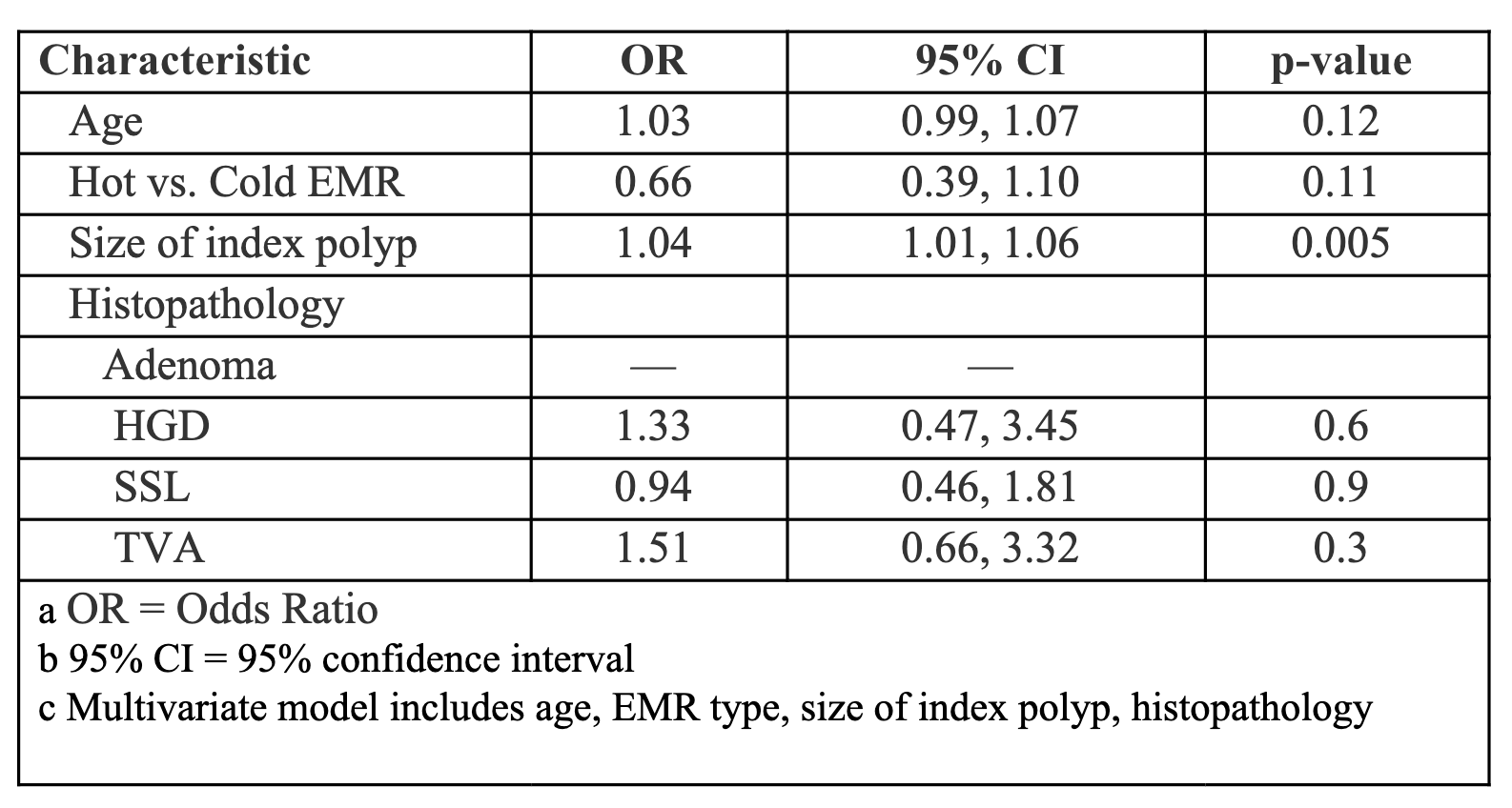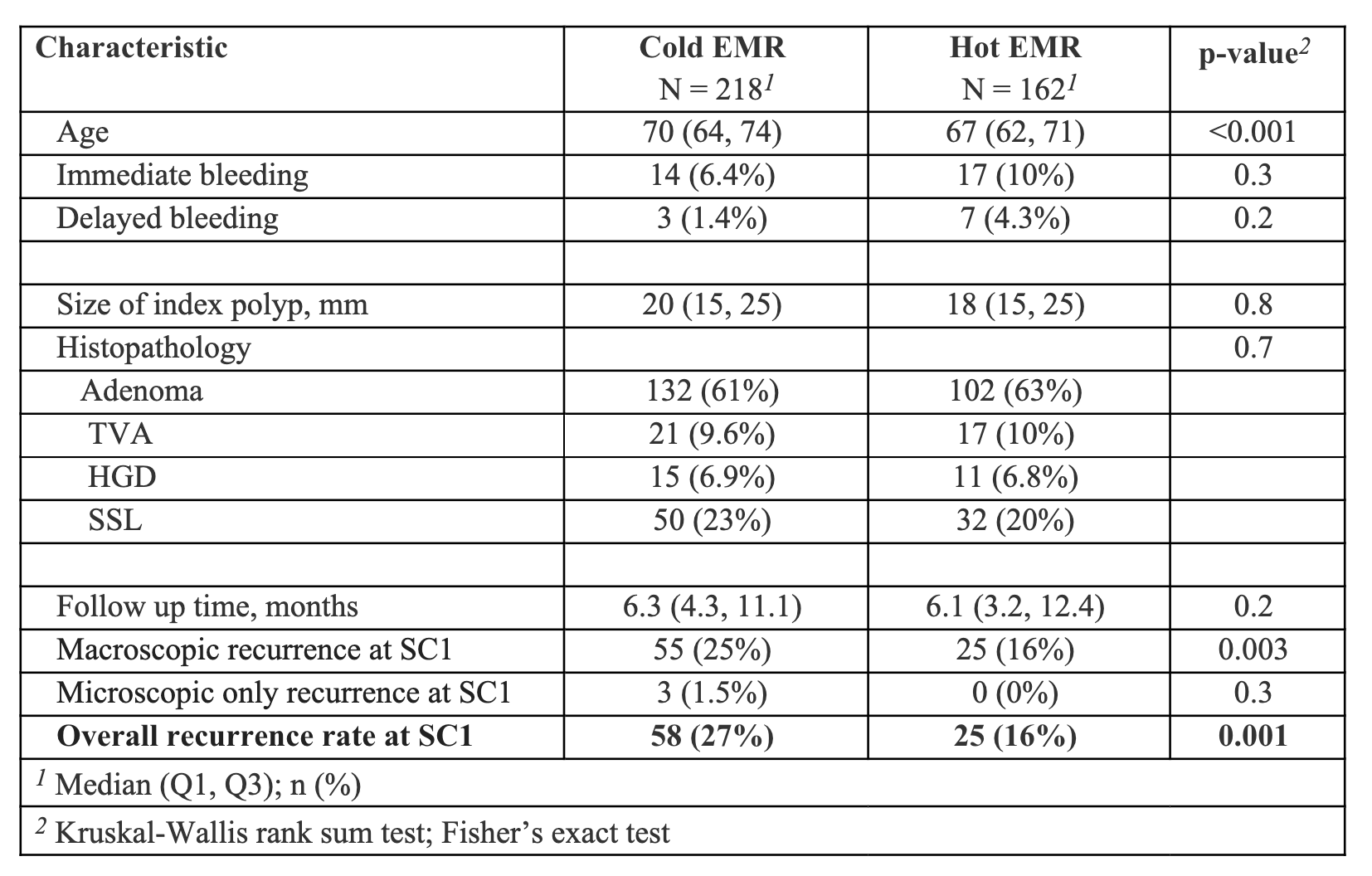Monday Poster Session
Category: Colon
P2405 - Cold vs Hot Endoscopic Mucosal Resection of Large Colorectal Polyps: A Single Center Experience
- PS
Pranit Sunkara, MD (he/him/his)
Wayne State University School of Medicine / Detroit Medical Center
Detroit, MI
Presenting Author(s)
1Wayne State University School of Medicine / Detroit Medical Center, Detroit, MI; 2Wayne State University School of Medicine /John D. Dingell VA Medical Center, Detroit, MI; 3John D. Dingell VA Medical Center & Wayne State University School of Medicine, Detroit, MI
Introduction:
Endoscopic mucosal resection (EMR) is a commonly used technique for the resection of large colorectal polyps. Prior data has shown that cold EMR provides a lower risk for adverse events, while cautery-assisted (hot) EMR has a lower recurrence rate. Our objective was to assess the outcomes of cold versus hot EMR of large polyps in a real-world setting at a single academic medical center.
Methods:
Patients who underwent colonoscopy and EMR of large polyps ≥ 1 cm from 2016 to 2023 and had first surveillance colonoscopy (SC1) were included in the analysis. Data regarding polyp size, histology, removal techniques, adverse events as well as polyp recurrence at SC1 were obtained. Characteristics of patients with and without a history of recurrent polyp at SC1 were compared using Fisher’s exact test for categorical variables and Kruskal-Wallis test for continuous variables. Predictors of recurrent polyp, estimates and 95% confidence intervals were derived from unconditional logistic regression model. The final multivariable logistic model was adjusted for age, removal technique (hot vs. cold EMR), size of index polyp, and histopathology of polyp.
Results:
A total of 380 polyps were included in the analysis with 162 polyps in the hot EMR group and 218 in the cold EMR group. Time to SC1 was similar between the hot and cold EMR groups (6.3 vs. 6.1 months, p=0.2). Hot EMR had higher rate of delayed post-polypectomy bleeding compared to cold EMR, but this was not statistically significant (4.3% vs 1.4%, p=0.2). There were no perforations. Recurrence rate at SC1 was lower in the hot EMR group compared to cold EMR group (16% vs 27%, p < 0.01). There were no cases of cancer at SC1. Increasing size of the polyp correlated with higher recurrence rate. Endoscopic resection was technically possible for all recurrences at SC1 in both groups.
Discussion:
Our findings suggest that large polyps resected with hot EMR have lower rates of recurrence compared to cold EMR, however with a trend towards higher rates of post-polypectomy bleeding. Increasing size of the index polyp was correlated with recurrence rate for both EMR groups. These results confirm findings of RCTs in real-world practice and suggest that both techniques are appropriate options for large non-pedunculated polyps.
Figure: Baseline characteristics and outcomes of hot versus cold EMR at SC1
Figure: Adjusted odds ratios (aORs) for polyp recurrence by EMR type
Disclosures:
Anshu Wadehra indicated no relevant financial relationships.
Pranit Sunkara indicated no relevant financial relationships.
Kirthi Lilley indicated no relevant financial relationships.
Ziad Kanaan indicated no relevant financial relationships.
Samara Rifkin indicated no relevant financial relationships.
Usman Rahim indicated no relevant financial relationships.
Fadi Antaki indicated no relevant financial relationships.
Anshu Wadehra, MD1, Pranit Sunkara, MD1, Kirthi Lilley, MD2, Ziad Kanaan, MD, PhD2, Samara Rifkin, MD2, Usman Rahim, MD1, Fadi Antaki, MD3. P2405 - Cold vs Hot Endoscopic Mucosal Resection of Large Colorectal Polyps: A Single Center Experience, ACG 2025 Annual Scientific Meeting Abstracts. Phoenix, AZ: American College of Gastroenterology.
